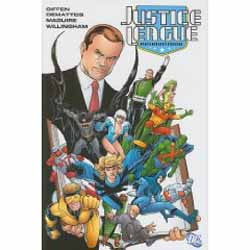
By Kieth Giffen, J.M. DeMatteis, Kevin Maguire, Al Gordon & various (DC Comics)
ISBN13: 978-1-84576-886-7
The revised follow-up volume of the (then) All-New, All-Hilarious Justice League completes the year long story-arc that introduced businessman and 1980’s archetype Max Lord, who reshaped the World’s Greatest Super-team for his own mysterious purposes.
The stories themselves (issues #8-13 of the monthly comicbook and Justice League Annual #1, plus the corresponding issue #13 of Suicide Squad – another great series long overdue for a decent trade paperback series!) are taken from a period when the major comics publishers were first developing the marketing strategies of the “Braided Mega-Crossover Event.â€
This hard-on-the-pockets innovation basically crafts a really big story involving every publication in a company’s output, for a limited time period – so a compilation like this perforce includes adventures that seem confusing because there are “middles†with no beginnings or endings. In this case the problem is deftly solved by inserting (mercifully) brief text pages explaining what’s happened elsewhere. It also doesn’t hurt that being a comedy-adventure, plot isn’t as vital as character and dialogue in this instance.
The merriment begins with ‘A Moving Experience’, where the heroes take possession of their various new UN embassy buildings, a sly and cynical tale of institutionalized ineptitude which is possibly one of the funniest single stories in American comic book history. Most main episodes at the start were followed by a brief back-up vignette drawn by Keith Giffen. ‘Old News’ deals with the closure of previous UN super-hero resource the Dome – which was summarily axed when the League achieved its international charter status.
‘Seeing Red’ is the first of two episodes forming part of the Millennium crossover hinted at above. Broadly, the Guardians of the Universe were attempting to create the next stage of human evolution, and their robotic enemies the Manhunters wanted to stop them. The heroes of Earth were asked to protect the Chosen Ones, but the robots had sleeper agents hidden among the friends and acquaintances of every hero on the planet.
Millennium was DC’s first weekly mini-series, and the monthly schedule of the other titles meant that a huge amount happened in the four weeks between their own tied-in issues: for example…
The Rocket Red attached to the JLI is in fact a Manhunter, who first tries to co-opt then destroy the team with an oil refinery, but by the second part, ‘Soul of the Machine’, the team are jarringly in deep space attacking the Manhunter home planet as part of a Green Lantern strike force. Nevertheless, the story is surprising coherent, and the all-out action is still well-leavened with superbly banter and hilarity.
The back-ups follow the suddenly unemployed Dome hero Jack O’Lantern to the terrorist state Bialya in ‘Brief Encounter’ and show an unfortunate training exercise for Blue Beetle and Mister Miracle in ‘…Back at the Ranch…’
JLI #11 began resolving all the mysteries of the first year by exposing the secret mastermind behind the League’s reformation. With ‘Constructions!’ and ‘Who is Maxwell Lord?’ (in #12) the series came full circle, and the whacky humour proved to have been the veneer over a sharp and subtle conspiracy plot worthy of the classic team. The drama and action kicked into high gear and the characters were seen to have evolved from shallow, if competent buffoons into a tightly knit team of world-beating super-stars – but still pretty darned addicted to buffoonery.
These two full length yarns precluded back-up tales but Giffen illustrated all of #13, wherein the team ran afoul of America’s highly covert Suicide Squad (super-villains blackmailed by the government into becoming a tractable metahuman resource – and without the annoying morality of regular superheroes).
‘Collision Course’ found the US agent Nemesis imprisoned in a Soviet jail with the League forced into the uncomfortable position of having to – at least ostensibly – fight to keep him there. The concluding part ‘Battle Lines’ from Suicide Squad #13 (written by John Ostrander and illustrated by Luke McDonnell and Bob Lewis) is a grim and gritty essay in superpower Realpolitik and a still a powerful experience two decades later.
This volume ends with ‘Germ Warfare’ from the first JLI Annual, drawn by Bill Willingham and inked by Dennis Janke, P. Craig Russell, Bill Wray, R. Campanella, Bruce Patterson and Dick Giordano. It is an uncharacteristically grim horror tale involving inhuman sacrifice and sentient Germ-warfare.
This collection is a breath of fresh air in a time where too many comic-books are filled with over-long, convoluted epics that are strident and oppressively angst-ridden. Here is great art, superb action and the light touch which still mark this series as a lost classic. So read this book and eagerly wait for further compilations to be released.
© 1987, 1992, 2007 DC Comics. All Rights Reserved.
